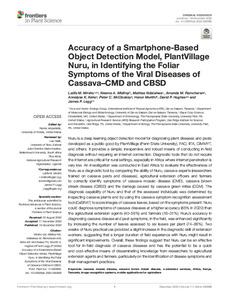| dc.contributor.author | Mrisho, L. |
| dc.contributor.author | Mbilinyi, N. |
| dc.contributor.author | Ndalahwa, M. |
| dc.contributor.author | Ramcharan, A. |
| dc.contributor.author | Kehs, A.K. |
| dc.contributor.author | McCloskey, P. |
| dc.contributor.author | Murithi, H. |
| dc.contributor.author | Hughes, D.P. |
| dc.contributor.author | Legg, J. |
| dc.date.accessioned | 2022-04-07T09:50:16Z |
| dc.date.available | 2022-04-07T09:50:16Z |
| dc.date.issued | 2020 |
| dc.identifier.citation | Mrisho, L., Mbilinyi, N., Ndalahwa, M., Ramcharan, A., Kehs, A.K., McCloskey, P., ... & Legg, J. (2020). Accuracy of a smartphone-based object detection model, PlantVillage Nuru, in identifying the foliar symptoms of the viral diseases of cassava–CMD and CBSD. Frontiers in Plant Science, 11: 590889, 1-14. |
| dc.identifier.issn | 1664-462X |
| dc.identifier.uri | https://hdl.handle.net/20.500.12478/7413 |
| dc.description.abstract | Nuru is a deep learning object detection model for diagnosing plant diseases and pests developed as a public good by PlantVillage (Penn State University), FAO, IITA, CIMMYT, and others. It provides a simple, inexpensive and robust means of conducting in-field diagnosis without requiring an internet connection. Diagnostic tools that do not require the internet are critical for rural settings, especially in Africa where internet penetration is very low. An investigation was conducted in East Africa to evaluate the effectiveness of Nuru as a diagnostic tool by comparing the ability of Nuru, cassava experts (researchers trained on cassava pests and diseases), agricultural extension officers and farmers to correctly identify symptoms of cassava mosaic disease (CMD), cassava brown streak disease (CBSD) and the damage caused by cassava green mites (CGM). The diagnosis capability of Nuru and that of the assessed individuals was determined by inspecting cassava plants and by using the cassava symptom recognition assessment tool (CaSRAT) to score images of cassava leaves, based on the symptoms present. Nuru could diagnose symptoms of cassava diseases at a higher accuracy (65% in 2020) than the agricultural extension agents (40–58%) and farmers (18–31%). Nuru’s accuracy in diagnosing cassava disease and pest symptoms, in the field, was enhanced significantly by increasing the number of leaves assessed to six leaves per plant (74–88%). Two weeks of Nuru practical use provided a slight increase in the diagnostic skill of extension workers, suggesting that a longer duration of field experience with Nuru might result in significant improvements. Overall, these findings suggest that Nuru can be an effective tool for in-field diagnosis of cassava diseases and has the potential to be a quick and cost-effective means of disseminating knowledge from researchers to agricultural extension agents and farmers, particularly on the identification of disease symptoms and their management practices. |
| dc.description.sponsorship | Consultative Group on International Agricultural Research |
| dc.description.sponsorship | Pennsylvania State University |
| dc.description.sponsorship | Bill & Melinda Gates Foundation |
| dc.description.sponsorship | Schmidt Futures |
| dc.description.sponsorship | Self Help Africa |
| dc.format.extent | 1-14 |
| dc.language.iso | en |
| dc.subject | African Cassava Mosaic Virus |
| dc.subject | Diseases |
| dc.subject | Plant Diseases |
| dc.subject | Africa |
| dc.subject | Kenya |
| dc.subject | Tanzania |
| dc.title | Accuracy of a smartphone-based object detection model, PlantVillage Nuru, in identifying the foliar symptoms of the viral diseases of cassava-CMD and CBSD |
| dc.type | Journal Article |
| cg.contributor.crp | Roots, Tubers and Bananas |
| cg.contributor.affiliation | International Institute of Tropical Agriculture |
| cg.contributor.affiliation | University of Dar es Salaam |
| cg.contributor.affiliation | Bayer Crop Science, United States |
| cg.contributor.affiliation | The Pennsylvania State University |
| cg.contributor.affiliation | Oak Ridge Institute for Science and Education |
| cg.coverage.region | Africa |
| cg.coverage.region | East Africa |
| cg.coverage.country | Tanzania |
| cg.coverage.hub | Eastern Africa Hub |
| cg.researchtheme | Plant Production and Health |
| cg.identifier.bibtexciteid | MRISHO:2020 |
| cg.isijournal | ISI Journal |
| cg.authorship.types | CGIAR and developing country institute |
| cg.iitasubject | Agronomy |
| cg.iitasubject | Cassava |
| cg.iitasubject | Disease Control |
| cg.iitasubject | Food Security |
| cg.iitasubject | Plant Breeding |
| cg.iitasubject | Plant Diseases |
| cg.iitasubject | Plant Health |
| cg.iitasubject | Plant Production |
| cg.journal | Frontiers in Plant Science |
| cg.notes | Open Access Journal; Published online: 18 Dec 2020 |
| cg.accessibilitystatus | Open Access |
| cg.reviewstatus | Peer Review |
| cg.usagerightslicense | Creative Commons Attribution 4.0 (CC BY 0.0) |
| cg.targetaudience | Scientists |
| cg.identifier.doi | https://dx.doi.org/10.3389/fpls.2020.590889 |
| cg.iitaauthor.identifier | James Legg: 0000-0003-4140-3757 |
| cg.futureupdate.required | No |
| cg.identifier.issue | 590889 |
| cg.identifier.volume | 11 |

